The first illustration shows the front cover of the book under review, and features a detail from a curtain embroidered by Lady Catherine Milnes Gaskell. The other illustrations come from the sources specified in the captions. Please note that the book itself is fully illustrated, with nearly seventy black-and-white pictures and a dozen lovely colour plates.
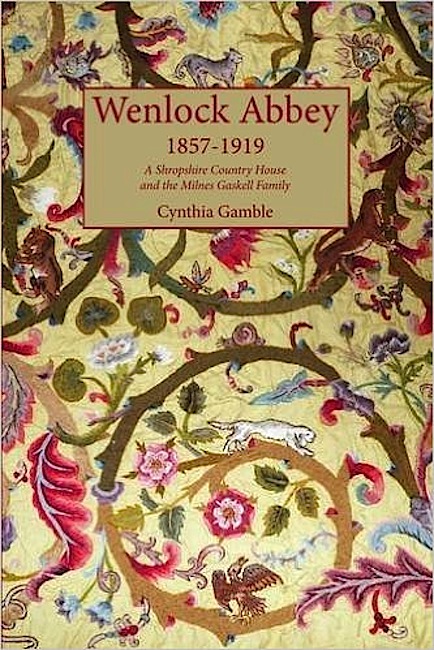
As Cynthia Gamble's sub-title indicates, her latest book, Wenlock Abbey, 1857-1919: A Shropshire Country House and the Milnes Gaskell Family, is both a house-history and a family history. The Milnes Gaskells were members of the landed gentry of Victorian and Edwardian times — that is, of the social and cultural elite who lived in a certain style, represented their localities in parliament, and were benefactors of their communities. These were the county folk who sent their sons to public school and Oxbridge, and who expected their daughters to marry into other such families. Not necessarily famous for their own achievements, they were friends of the famous, opening their elegant and well-run houses to statesmen, authors and artists of all kinds, and facilitating friendships between them. They were privileged, of course, but many of them were imbued with ideals of duty, and gave back generously. They deserve to be remembered with gratitude, and, when unpublished archives are made available, and researchers are willing to immerse themselves in them, the result can be a valuable and entertaining slice of social history as well as a tribute.
That is certainly true in this case. The story of the Milnes Gaskells of Wenlock Abbey in Much Wenlock, Shropshire, close to the Welsh border, starts in 1857. This was when James Milnes Gaskell, long-serving Conservative MP for Wenlock, purchased the ruined "Abbey" there, which included a large residential property. The estate was in fact that of a medieval Cluniac priory, and the L-shaped property, part-Norman, part-fifteenth-century, was originally the prior's lodging. This now became a family home. Much was done to explore, excavate, study and preserve the quite spectacular ruins on the site, which, at a time when such ruins were much in vogue, had been painted by the likes of Paul Sandby and sketched by Turner, John Sell Cotman, Ruskin and others. Much needed to be done, too, to render the house habitable, convenient and finally comfortable. From the beginning, the restoration work was remarkably sensitive, undertaken by a family who saw themselves as guardians rather than owners of heritage buildings. For example, we learn from the artist Louis de Wet, the present owner, that the old stone spiral staircases in the house were retained, with "modern wooden flights of stairs tactfully inserted" (Preface, xxxv). But it was a long process. In 1862, James's sister-in-law reported feeling frozen stiff there, as draughts swept in under the massive wooden doors. "The cold is beyond what I ever felt," she wrote to a friend, adding however that "the building is so full of interest that one bears it" (qtd. in Gamble 20).
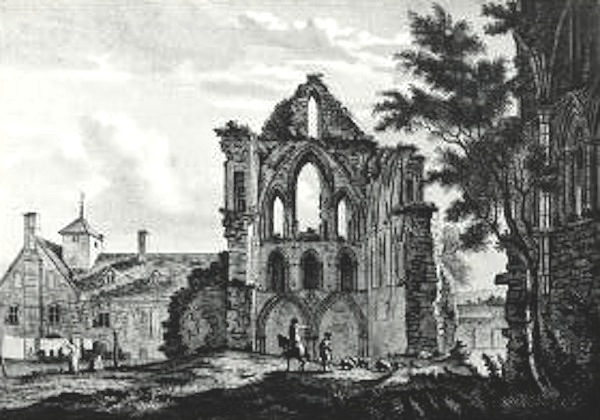
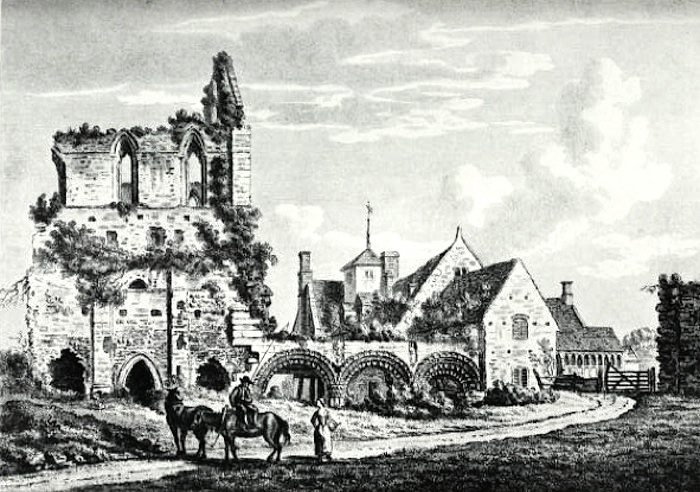
Two views of Wenlock Abbey in 1778, from engravings after Paul Sandby's drawings. In the left-hand one, the house is on the left; in the right-hand one, it is on the right. Source: Gaskell, Spring in a Shropshire Abbey, frontispiece, and facing p. 202.
In time, and with the continuing efforts of James's elder son and heir Charles, the house was suitably modernised. An article in Country Life, most probably written by Charles himself, explains that "necessary alterations were planned, as far as possible, to emphasise rather than efface the Gothic work, and in a spirit of preservation rather than of 'restoration'" (242). This was no idle claim. In 1894, for instance, when running water was finally brought in, Charles based the design for a new wellhead on a medieval one sketched by the French architect Viollet-le-Duc in his influential Dictionnaire raisonné de l'architecture of 1854-68. This great landmark work was a favourite of his. He had written about it earlier, and had even given a copy of it as a wedding present to his close friend, the American historian Henry Adams. Many amateur architects planned or helped to plan changes to their country homes in the Victorian period, but Charles was a cut above the average. Influenced not only by Viollet-le-Duc but also by Philip Webb, William Morris and Ruskin, he sharply criticised those who treated their inherited properties in a cavalier manner, and campaigned on behalf of other imperilled buildings as well as taking scrupulous care of his own. In such hands, the house at Much Wenlock was brought forward into a new age without losing its original character and atmosphere.
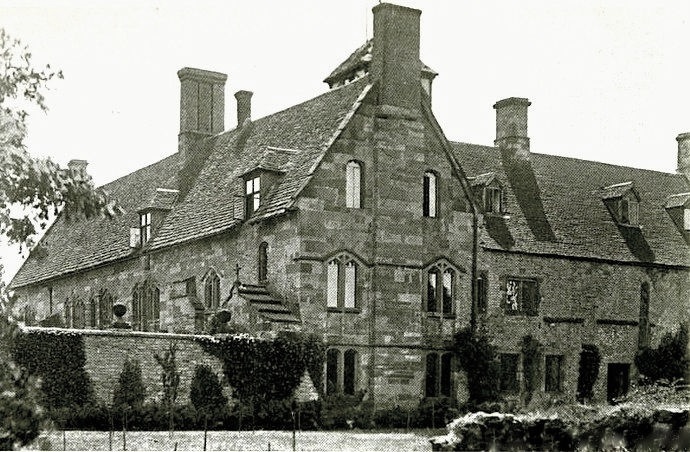
"The Abbey Farmery" (the house). Source: Gaskell, Old Shropshire Life, facing p. 150.
Visitors were made welcome from the start, arriving in greater numbers once the main passenger railway station opened in Much Wenlock in 1864. Amazingly, more than a hundred people signed the Visitors' Book in 1866 alone, among them the poet Robert Bridges, and William Whetmore Story (one of the best-known of the American sculptors based in Italy). Henry Adams was one of the earliest and most regular guests. The New Englander had met Charles first as a young man when they were both breakfasting at the home of Sir Henry Holland, the Queen's physician. Their friendship had blossomed, and Adams would see the changes in the house at first hand, visiting first in the October of 1864 (when he too felt the cold, at the beginning of what turned out to be an exceptionally chilly winter), and later spending part of his honeymoon there with his wife Marian in 1872. He and Marian would return to Much Wenlock in 1880, and he came again in November 1891 and briefly in the summer of 1898. By then the "old barn" of his first visit (qtd. in Gamble 37) had become a thriving salon. Cementing the transatlantic link, his fellow-countryman Henry James had first visited in the summer of 1877, and had returned in 1878, when the various other guests gave him ample material for his future work. Writing to Elinor Dean Howells on this occasion, James described the place as "one of the most romantic and curious old houses in England.... delightfully picturesque" (qtd. in Gamble 160). He was back again in 1882. The claim that James's "stays at Wenlock Abbey inspired much of his writing" (Gamble xxv) may seem a large one but, as Gamble has shown in an earlier book, John Ruskin, Henry James and the Shropshire Lads (2008), there is much to support it.
Since late 1876, one of the Abbey's great draws had been Charles's wife Catherine. She had been sketched by Rossetti that very year, and everyone who visited seemed to fall in love with her. When James first came to stay, he reported back to Adams that she was a "rose without a thorn.... singularly charming ... a perfect English beauty of the finest type" (qtd. in Gamble 156). Her skill with embroidery, as illustrated by the book's front cover, was only one of her accomplishments. A later guest, Thomas Hardy, told his close friend Florence Henniker how magically the evenings passed at the Abbey, as they all sat on the lawn telling stories in the starlight. Catherine had an interest in folklore and an aptitude for mimicry. She herself ventured into print, collecting local tales, writing sketches and short plays for performance at home, and describing life at the Abbey in two delightful books about it, the first one Spring in a Shropshire Abbey dedicated to her friend, the artist and gardening writer, Eleanor Vere Boyle. The last one, Friends round the Wrekin was particularly well received: "All that she writes she invests with an air of delicate distinction," enthused the Spectator reviewer (qtd. in Gamble 266). Photographs of costumed performers there at the end of Chapter 20 give an idea of the home entertainment on offer, and help to explain why people were drawn to the Abbey even from the start, when it still lacked creature comforts.
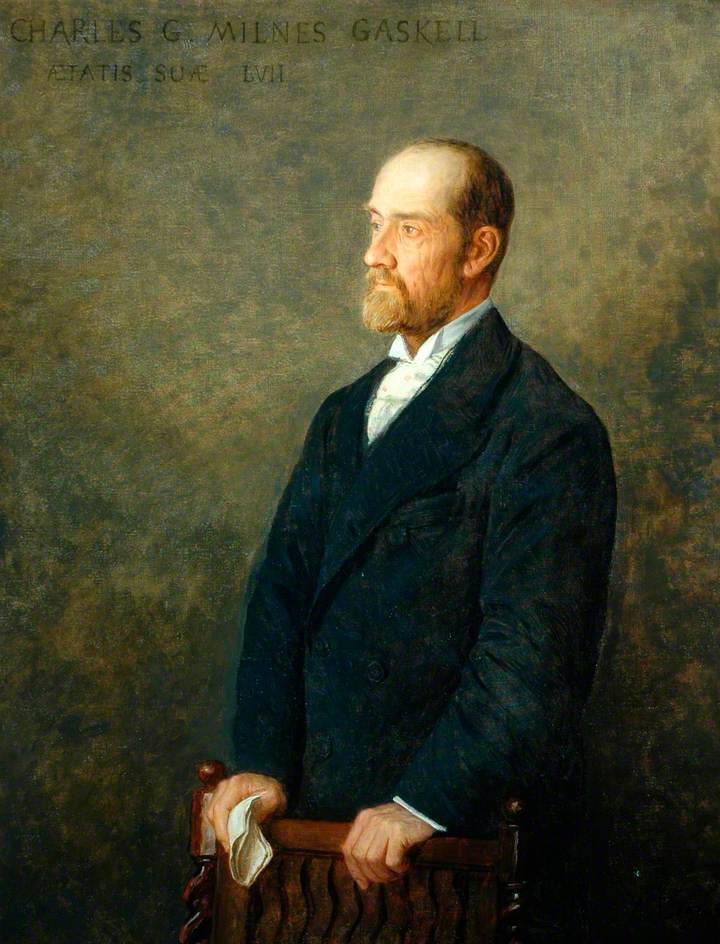
Charles Milnes Gaskell, aged 57. Reproduced by kind permission of Wakefield Council.
The family's personal history is obviously an important part of the whole story, and one of the greatest pleasures of reading the book is getting to know the different members. While everyone who visited sang the praises of Catherine, Charles was the backbone. A gifted classicist, he was called to the bar in 1866, and took on various public duties in later life, including that of MP for Morley in Yorkshire, representing that constituency for seven years, from 1885-1902. He would receive one of the inaugural honorary LLDs from the University of Leeds in 1904. As mentioned above, his interests ranged far beyond the Abbey, and this too helps to explain the couple's large circle of friends. Their long and varied guest list included not only writers and artists of all kinds, but exceptional people in other areas as well, such as the explorers Henry Morton Stanley and Isabella Bishop (née Bird). Having endured all sorts of extremes during her worldwide travels, the latter would not have minded a few draughts at the Abbey!
With hosts like the Milnes Gaskells and fellow-guests like these, visits to the Abbey were bound to be enjoyable. It is amusing to see how James suffered when he visited a more typical country house, that of Catherine's parents. Here, at Eggesford Manor, the younger family members were not much in evidence, and the head of the household was off hunting all the time. Worse, as the novelist complained to Adams at the time, the house was full of "awfully bad" pictures of horses — "the "whole thing is dull," he moaned (qtd. in Gamble 160). His experiences at Wenlock had spoiled him.
Not that everything was plain sailing for the Milnes Gaskells themselves. They had the normal quota of troubles, which Gamble records sympathetically, and which brings them to life for us. Charles, for example, was bitterly disappointed to lose his first parliamentary election in Pontefract in 1868, and suffered a broken engagement in the same year. In 1869, the premature loss of his kind, cultured and stoical mother to cancer was an even greater blow to him. A strong supporter of Gladstone, he stood for parliament again in the general election of 1874, as Liberal candidate for Wenlock, only to suffer another resounding defeat. Those trials make his and Catherine's happiness together later in the 70s all the more pleasing: Henry James, reporting back to Adams in 1877, judged Catherine to be "intensely in love with her husband" (qtd. in Gamble 156). Another low point in the family history came much later. For reasons which remain unclear, Catherine more or less disinherited her elder child and only son, Evelyn. Fortunately, Gamble is not given to speculation, but it does seem that he was affected by his difficult wartime experiences, and was unfitted to manage such a precious heritage as the Abbey represented. He would predecease his widowed mother anyway, depriving her of her only son, as well as leaving a widow and children of his own.
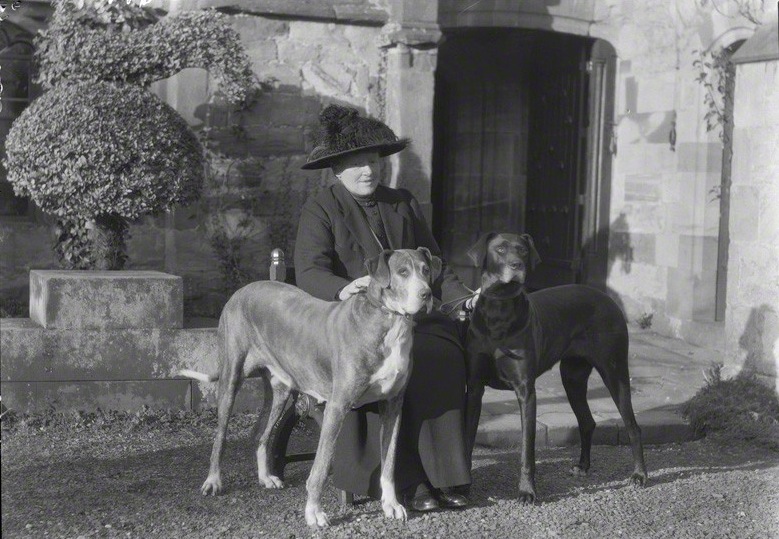
Lady Catherine in later life, by Lafayette (Lafayette Ltd), half-plate film negative, 28 November 1927, © National Portrait Gallery, London, by kind permission. NPG x184746.
This episode stands outside the main events of Gamble's work, which focuses mainly on the fortunes of the estate up to Charles's death in 1919. But an epilogue brings both strands of the history up to 1935, when Catherine passed away, and ends with some information about the Abbey's present situation. De Wet and his wife, the actress Gabrielle Drake, have owned and clearly treasured the house itself since 1983, while the remarkable ruins themselves are now in the care of English Heritage. There is much more in Gamble's detailed and scholarly account than can be touched on in a brief review, and those who read it will undoubtedly find many other points of interest, and be inspired to visit the Abbey ruins for themselves. Then they will be able to experience "the atmosphere of seclusion and peace" to which Henry Adams responded (qtd. in Gamble 230), and may wonder, like him, if so-called progress has not deprived us of the contentment we might have achieved in such a setting.
Related Material
- A note added by the author
- Embroidered curtain by Lady Catherine
- Angeli Laudantes for Holy Trinity Church, Much Wenlock, by Lady Catherine
Bibliography
[Book under review] Gamble, Cynthia. Wenlock Abbey, 1857-1919: A Shropshire Country House and the Milnes Gaskell Family. Much Wenlock, Shropshire: Ellingham Press, 2015. 319 + xxxvi pp. £18.99. ISBN 978-0-9939973-1-6.
[Illustration source] Gaskell, Catherine Henrietta Milnes, Lady. Old Shropshire Life. London and New York: John Lane: The Bodley Head, 1904. Internet Archive. Contributed by University of California Libraries. Web. 1 December 2015.
[Illustration source] Gaskell, Catherine Henrietta Milnes, Lady. Spring in a Shropshire Abbey. London: Smith, Elder & Co., 1905. Internet Archive. Contributed by University of California Libraries. Web. 1 December 2015.
Created 1 December 2015